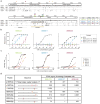Broadly neutralizing antibodies from human survivors target a conserved site in the Ebola virus glycoprotein HR2-MPER region
- PMID: 29736037
- PMCID: PMC6030461
- DOI: 10.1038/s41564-018-0157-z
Broadly neutralizing antibodies from human survivors target a conserved site in the Ebola virus glycoprotein HR2-MPER region
Abstract
Ebola virus (EBOV) in humans causes a severe illness with high mortality rates. Several strategies have been developed in the past to treat EBOV infection, including the antibody cocktail ZMapp, which has been shown to be effective in nonhuman primate models of infection 1 and has been used under compassionate-treatment protocols in humans 2 . ZMapp is a mixture of three chimerized murine monoclonal antibodies (mAbs)3-6 that target EBOV-specific epitopes on the surface glycoprotein7,8. However, ZMapp mAbs do not neutralize other species from the genus Ebolavirus, such as Bundibugyo virus (BDBV), Reston virus (RESTV) or Sudan virus (SUDV). Here, we describe three naturally occurring human cross-neutralizing mAbs, from BDBV survivors, that target an antigenic site in the canonical heptad repeat 2 (HR2) region near the membrane-proximal external region (MPER) of the glycoprotein. The identification of a conserved neutralizing antigenic site in the glycoprotein suggests that these mAbs could be used to design universal antibody therapeutics against diverse ebolavirus species. Furthermore, we found that immunization with a peptide comprising the HR2-MPER antigenic site elicits neutralizing antibodies in rabbits. Structural features determined by conserved residues in the antigenic site described here could inform an epitope-based vaccine design against infection caused by diverse ebolavirus species.
Conflict of interest statement
C.B., E.D., and B.J.D. are employees of Integral Molecular. B.J.D. is a shareholder of Integral Molecular. J.E.C. is a consultant for Sanofi, and is on the Scientific Advisory Boards of PaxVax, CompuVax, GigaGen, Meissa Vaccines, is a recipient of previous unrelated research grants from Moderna and Sanofi and is founder of IDBiologics. A.I.F., P.A.I., A.B and J.E.C. are co-inventors on a patent applied for that includes the BDBV223, BDBV317, and BDBV340 antibodies.
Figures




Similar articles
-
Multifunctional Pan-ebolavirus Antibody Recognizes a Site of Broad Vulnerability on the Ebolavirus Glycoprotein.Immunity. 2018 Aug 21;49(2):363-374.e10. doi: 10.1016/j.immuni.2018.06.018. Epub 2018 Jul 17. Immunity. 2018. PMID: 30029854 Free PMC article.
-
Epitope-focused immunogen design based on the ebolavirus glycoprotein HR2-MPER region.PLoS Pathog. 2022 May 18;18(5):e1010518. doi: 10.1371/journal.ppat.1010518. eCollection 2022 May. PLoS Pathog. 2022. PMID: 35584193 Free PMC article.
-
Antibody-Mediated Protective Mechanisms Induced by a Trivalent Parainfluenza Virus-Vectored Ebolavirus Vaccine.J Virol. 2019 Feb 5;93(4):e01845-18. doi: 10.1128/JVI.01845-18. Print 2019 Feb 15. J Virol. 2019. PMID: 30518655 Free PMC article.
-
Structural Biology Illuminates Molecular Determinants of Broad Ebolavirus Neutralization by Human Antibodies for Pan-Ebolavirus Therapeutic Development.Front Immunol. 2022 Jan 10;12:808047. doi: 10.3389/fimmu.2021.808047. eCollection 2021. Front Immunol. 2022. PMID: 35082794 Free PMC article. Review.
-
Achieving cross-reactivity with pan-ebolavirus antibodies.Curr Opin Virol. 2019 Feb;34:140-148. doi: 10.1016/j.coviro.2019.01.003. Epub 2019 Mar 15. Curr Opin Virol. 2019. PMID: 30884329 Free PMC article. Review.
Cited by
-
Human Monoclonal Antibody Derived from Transchromosomic Cattle Neutralizes Multiple H1 Clades of Influenza A Virus by Recognizing a Novel Conformational Epitope in the Hemagglutinin Head Domain.J Virol. 2020 Oct 27;94(22):e00945-20. doi: 10.1128/JVI.00945-20. Print 2020 Oct 27. J Virol. 2020. PMID: 32847862 Free PMC article.
-
Ebola vaccine-induced protection in nonhuman primates correlates with antibody specificity and Fc-mediated effects.Sci Transl Med. 2021 Jul 14;13(602):eabg6128. doi: 10.1126/scitranslmed.abg6128. Sci Transl Med. 2021. PMID: 34261800 Free PMC article.
-
Inhalation monoclonal antibody therapy: a new way to treat and manage respiratory infections.Appl Microbiol Biotechnol. 2021 Aug;105(16-17):6315-6332. doi: 10.1007/s00253-021-11488-4. Epub 2021 Aug 23. Appl Microbiol Biotechnol. 2021. PMID: 34423407 Free PMC article. Review.
-
A Pan-Ebolavirus Monoclonal Antibody Cocktail Provides Protection Against Ebola and Sudan Viruses.J Infect Dis. 2023 Nov 13;228(Suppl 7):S691-S700. doi: 10.1093/infdis/jiad205. J Infect Dis. 2023. PMID: 37288609 Free PMC article.
-
Growth-Adaptive Mutations in the Ebola Virus Makona Glycoprotein Alter Different Steps in the Virus Entry Pathway.J Virol. 2018 Sep 12;92(19):e00820-18. doi: 10.1128/JVI.00820-18. Print 2018 Oct 1. J Virol. 2018. PMID: 30021890 Free PMC article.
References
-
- Lyon GM, et al. Clinical care of two patients with Ebola virus disease in the United States. N Engl J Med. 2014;371:2402–2409. - PubMed
-
- Qiu X, et al. Characterization of Zaire ebolavirus glycoprotein-specific monoclonal antibodies. Clin Immunol. 2011;141:218–227. - PubMed
-
- Qiu X, et al. Successful treatment of ebola virus-infected cynomolgus macaques with monoclonal antibodies. Sci Transl Med. 2012;4:138ra181. - PubMed
Publication types
MeSH terms
Substances
Grants and funding
LinkOut - more resources
Full Text Sources
Other Literature Sources
Medical
Miscellaneous

